The divine chariots of jagannath puri!
The Jagannath Temple at Puri is among the most revered Vaishnava sites in India and the current temple was built by Anantavarman of the Chodaganga dynasty in the 12th century. The deities in the sanctum are associated with King Indrayumna of the Iksvaku dynasty.
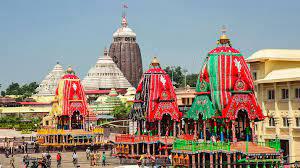
The Ratha Yatra festival of lord Jagannath celebrated in the month of Asadha (June-July) attracts innumerable devotees from across the world every year. The spontaneous display of mass devotion & religious fervour,gaiety,colours which take place on the Bada danda of Puri is a mesmerizing sight to behold.
The uniqueness of Lord Jagannath lies in the fact that originally a deity worshipped by the autochthonous Sabaras came to occupy the highest position in the Hindu pantheon. Jagannath or Purushottama cult absorbed all major religious movements & philosophy which have swept the Indian subcontinent & has evolved a syncretism which is unique in character.
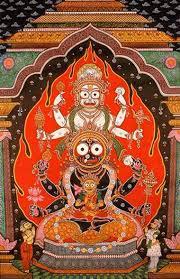
Believed to be the oldest chariot procession in the world, this festival marks the annual ceremonial procession of Lord Jagannath, his elder brother Balabhadra and younger sister Subhadra, from their temple to the Gundicha temple,which is believed to be their aunt's home.
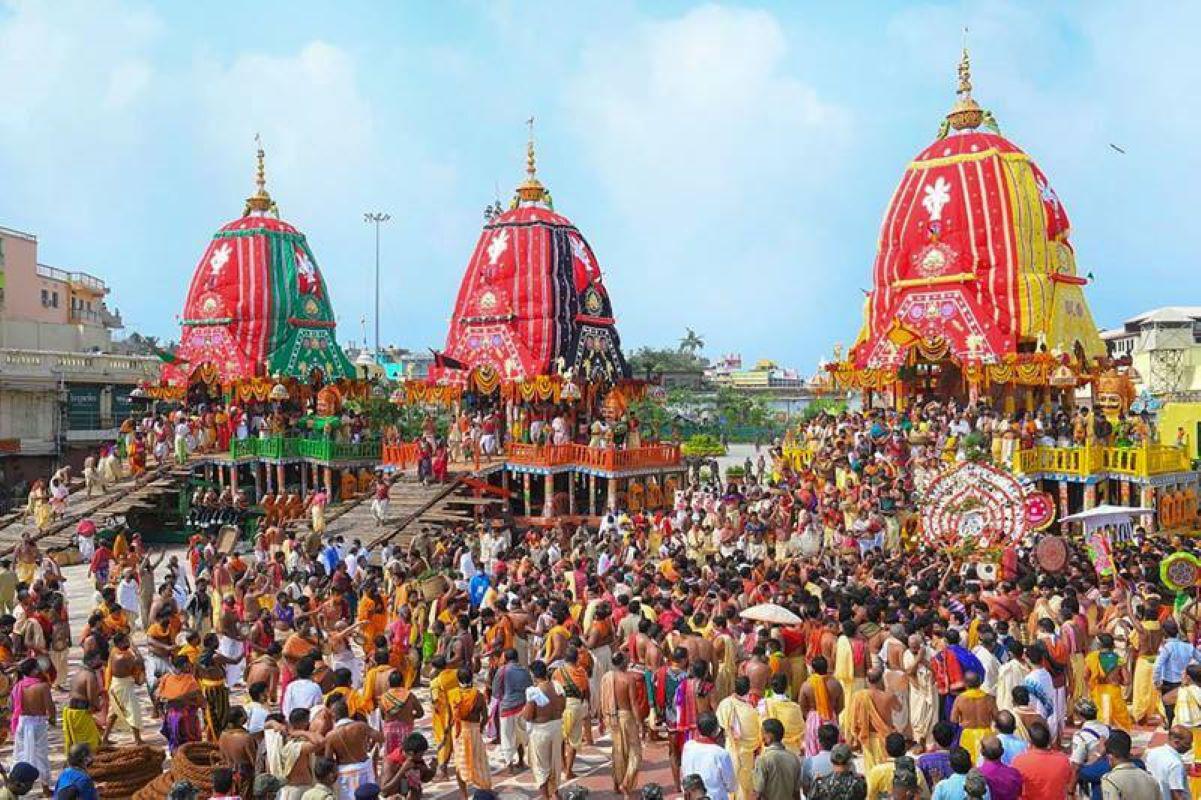
Descriptions of Rathyatra are found in Brahma Purana, Padma Purana, and Skanda Purana. Kapila Samhita also refers to Ratha Yatra.The then ruling Ganga dynasty instituted the Ratha Yatra after the completion of the great temple around 1150 AD.The size, pomp and splendour of this ratha Yatra has even contributed a word to the English dictionary: Juggernaut.

The construction of the chariots start from the auspicious day of the Akshaya Tritiya and the timber is brought from the forests of Daspalla.
"Chariot Details"
| Chariot Details | Jagannath |
|---|---|
| Name of Chariot | Nandighosha (ନନ୍ଦିଘୋଷ) |
| Alternates name of Chariot | Garudadhwaja, Kapiladhwaja |
| Number of wheels | 16 |
| Total Number of wooden pieces used | 832 |
| Height | 44' 2" |
| Length and breadth | 34'6" x 34'6" |
| Colours of the canopies | Red, Yellow
(yellow associated with Vishnu) |
| Guardian | Garuda |
| Charioteer | Daruka |
| Flag name | Trailokyamohini |
| Flag emblem | |
| Name of Horses |
|
| Colour of Horses | White |
| Name of Chariot Rope | Sankhachuda Nagini |
| Accompanying deity | Madanmohan |
| Gatekeepers (Dvarapala) |
|
| Nine parshvadevata (Subsidiary deities) |
|
| Chariot Details | Balabhadra |
| Name of Chariot | Taladhwaja (ତାଳଧ୍ୱଜ) |
| Alternates name of Chariot | Langaladhwaja |
| Number of wheels | 14 |
| Total Number of wooden pieces used | 763 |
| Height | 43' 3" |
| Length and breadth | 33' x 33' |
| Colours of the canopies | Red, Bluish green |
| Guardian | Vasudeva |
| Charioteer | Matali |
| Flag name | Unnani |
| Flag emblem | Palm Tree |
| Name of Horses |
|
| Colour of Horses | Black |
| Name of Chariot Rope | Basuki Naga |
| Accompanying deity | Ramakrishna |
| Gatekeepers (Dvarapala) |
|
| Nine parshvadevata (Subsidiary deities) |
|
| Chariot Details | Subhadra |
| Name of Chariot | Darpadalana (ଦର୍ପଦଳନ) |
| Alternates name of Chariot | Devadalana, Padmadhwaja |
| Number of wheels | 12 |
| Total Number of wooden pieces used | 593 |
| Height | 42' 3" |
| Length and breadth | 31'6" x 31'6" |
| Colours of the canopies | Red, Black
(Black associated with the Goddess) |
| Guardian | Jayadurga |
| Charioteer | Arjuna |
| Flag name | Nadambika |
| Flag emblem | |
| Name of Horses |
|
| Colour of Horses | Red |
| Name of Chariot Rope | Swarnachuda Nagini |
| Accompanying deity | Sudarshana |
| Gatekeepers (Dvarapala) |
|
| Nine parshvadevata (Subsidiary deities) |
credit:wikipedia
Except the ' kalasa' which are placed on top of the chariots,the 14 side deities,charioteers & horses,all other parts of the chariots are constructed anew every year.
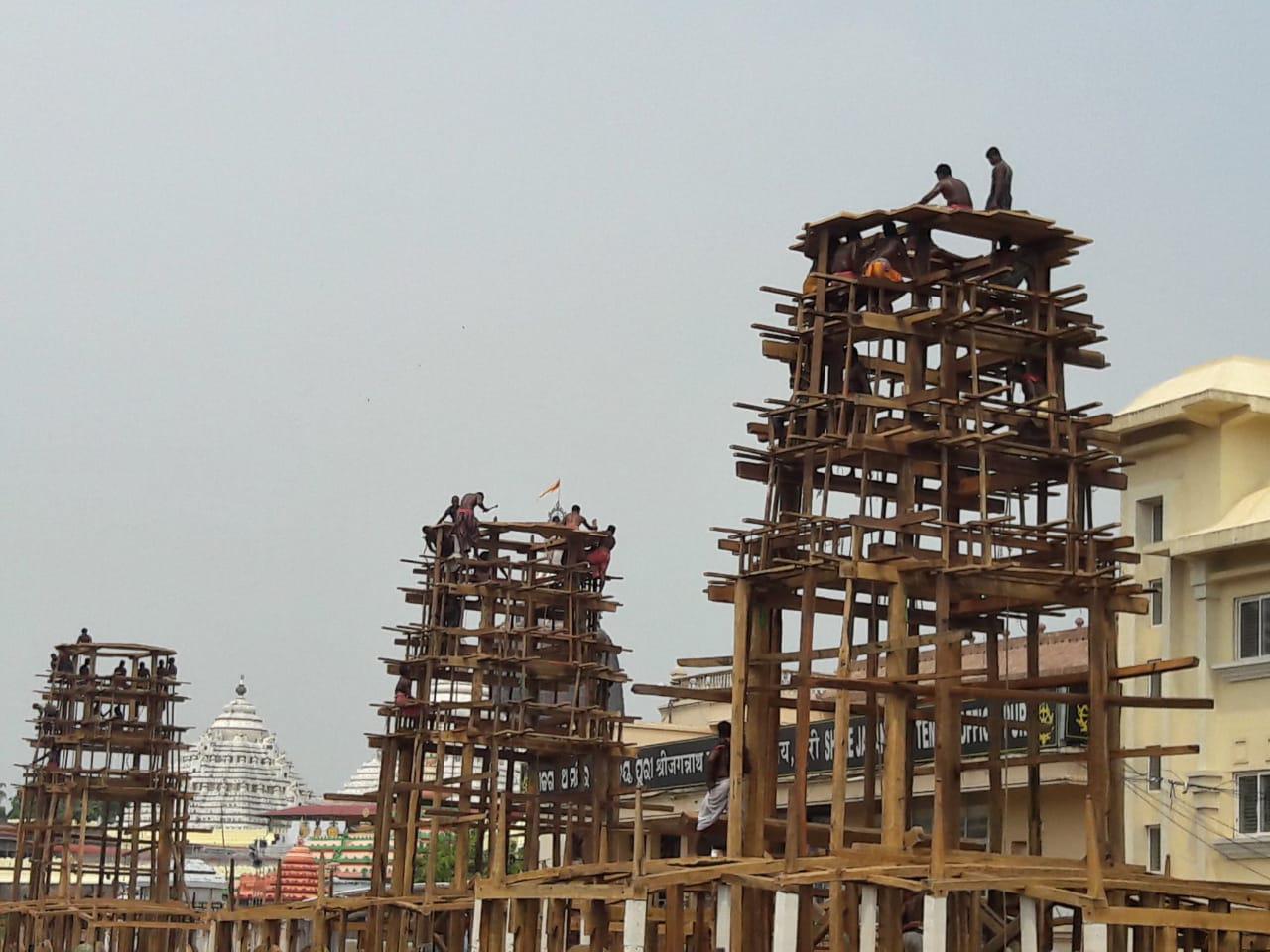
The construction of the chariots is a complicated process with 34 components,bearing a separate name.This task is performed by carpenters who are traditionally associated with it from generation to generation.Painters or chitrakaras,tailors also play a role in it.The chariot for Jagannath is approximately 44 feet high and 35 feet square and takes about 2 months to construct.Balabhadra’s Taladvaja rath is 43 ft and carries a Tala fruit at the top.Devi Subhadra’s Devidalana rath is 42 ft and covered with red and black drapes.
The chariots of the 3 deities have a number of side deities or 'parswa devatas' which represent the entire pantheon of Hindu deities along with the original autochthonous deity of Jagannath. The pantheism of Jagannath cult has absorbed all over the ages while rejecting none.
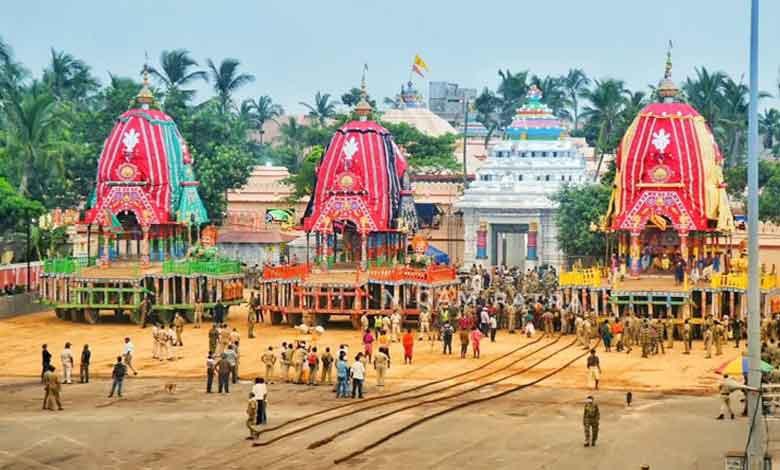
The deities begin their return journey on Ashadha Shukla Paksha Dashami & it's known as Bahuda jatra.Interestingly, the Ratha Yatra is also seen as the journey of life undertaken to achieve Moksha.The ratha is a symbolical representation of a body, and the yatra is the path undertaken in every birth. The body/shareer undertakes the journey/yatra in every birth to reach the final destination (moksha); and the yatra is known as Rath Yatra.
According to the Hindu scriptures, Krishna resides in our mind but we forget the divinity due to our ignorance and mundane daily existence.Pulling the chariot rope with shradha & bhakti while chanting the lord's name awakens the inner divinity & helps attain liberation.
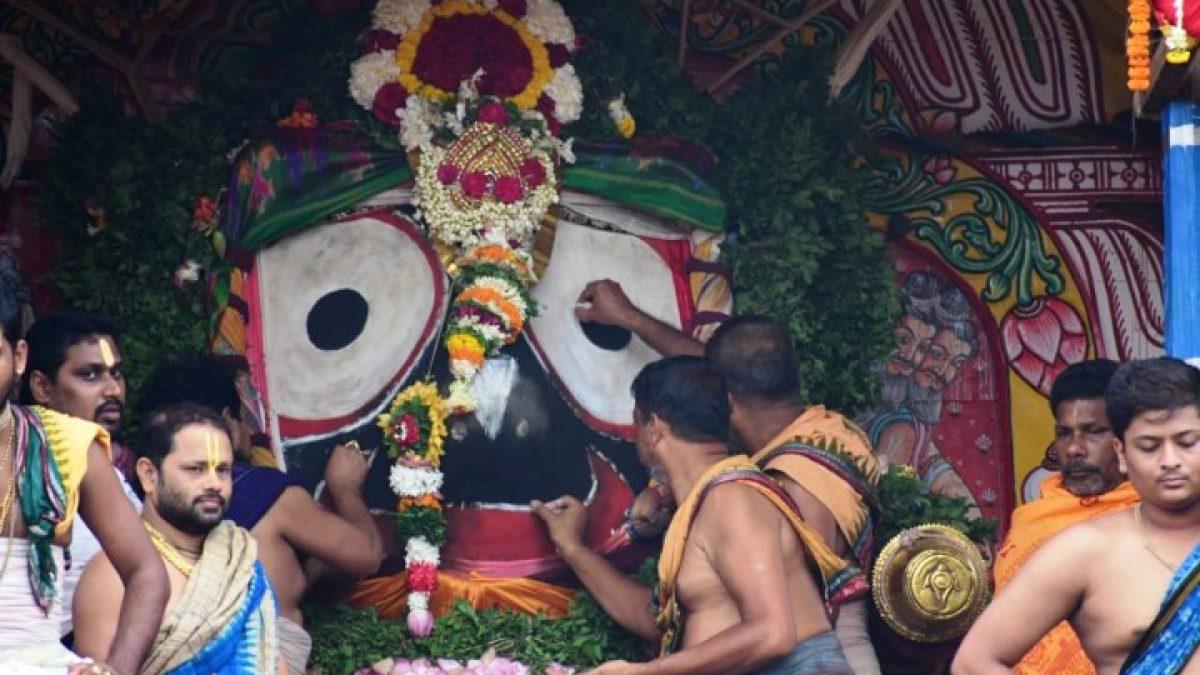
In bhakti, we depend on the Lord Jagannath's strength, not our own.What is important is not the specific manner in which God is worshiped but the degree to which the devotee is filled with love.
atmanam rathinam viddhi sariram rathameva tu
buddhim tu sarathim viddhi manh pragrahameva cha
indrayani hayarmahur visayam stenu gocharan
atmendriaya monoyuktam bhoktetyahur manasinah.
Translation: Body is the chariot, soul is the charioteer. Senses are horses. Mind is the bridle. All the sensory objects constitute the root for the horses. The co-ordination among the soul, senses and mind will help the sincere devotee to liberate himself & attain moksha.
It is believed that anyone who pulls the rope linked to the chariots of the trinity and helps others also in doing so gets the merit of several penances and his sins are washed away.All the paraphernalia linked to the Lord Jagannath Rath Yatra is to help the devotee spiritually become one with the deity himself.
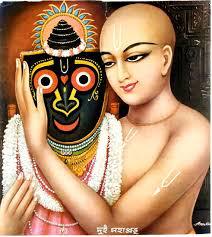
The eigth stanza of Jagannath ashtakam composed by Adi Shankara:
hara tvaṁ saṁsāraṁ druta-taram asāraṁ sura-pate
hara tvaṁ pāpānāṁ vitatiṁ aparāṁ yādava-pate
aho dīne 'nāthe nihita-caraṇo niścitam idaṁ
jagannāthaḥ svāmī nayana-patha-gāmī bhavatu me (8)
O Lord of the demigods, please quickly remove this useless material existence I am undergoing. O Lord of the Yadus, please destroy this vast ocean of sins which has no shore.Lord Jagannatha’s lotus feet are bestowed upon those who feel themselves fallen and have no shelter in this world but Him. May that Jagannatha Swami be the object of my vision.
images credit:internet
Comments (11)










